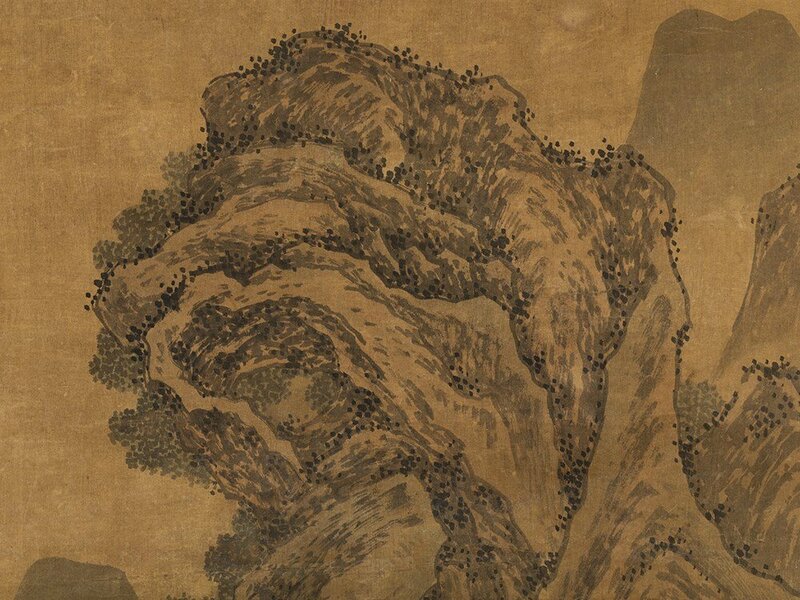Wang Hui (1632-1717, Scroll ‘Rolling Landscape’, China
Wang Hui (1632-1717, Scroll ‘Rolling Landscape’, China. Photo courtesy Auctionata.
Wang Hui (1632-1717) – master of Chinese painting. With calligraphy, artist’s signature ‘Shi Gu Zi Wang Hui’ ??? (Wang Hui’s artist’s name) ?? and four seals. Mounted on paper in a silk frame, wooden handles. Overall dimensions: 235 x 63 cm. Image size: 143 x 48.5 cm. The scroll painting shows significant signs of age and wear. The material is browned and shows creases. There are partially foxing and large water stains, especially on the mount. There is some material loss with small restorations and color touch-ups here and there. Estimate €8,000 – €10,000
Provenance: from a German private collection, acquired in Burma in 1970
This stunning landscape was created by the master of Chinese painting Wang Hui (1632-1717). It shows a hilly landscape, which extends across different perspectival planes. The structure is strongly vertical. High, towering trees and steep rocky mountains define the composition. Amid the pine trees – as symbols of longevity – one recognizes pagodas and several figures. The wide open space and the idyll of the landscape are masterfully rendered. Although Wang Hui was strongly inspired by the tradition of Chinese painting, he nevertheless managed to create works in his own style. His depictions of nature are never mere copies but always a synthesis of historical landscape paintings, in which he exhibits his skilful brushwork. Fine lines and dabs of color give shape to the natural environment. The composition type is based on that of Wang Meng (1308-1385). Similarly, the huge trees in the foreground and the wavy outlines of the mountain peaks in the background are reminiscent of the brushwork of the well-known Chinese landscape painter from the 14th century.
There is a calligraphic poem about the Tian-Tai Mountains in Zhejiang province, the artist's signature ‘Shi Gu Zi Wang Hui’ ???and two seals in the upper left. Wang Hui had the courtesy name Shigu or Shiguzi, which can be identified here in the inscription. Further seals are located in the lower right and left corner.
The work is mounted on paper in a silk frame. The painting has a suspension and wooden handles. There is a label on the back of the mount.
Wang Hui (1632-1717).
Wang Hui was born into a family of artists and learned his craft at a very early. Later he was a pupil of Zhang Ke and Wang Shimin, two artists of the so-called ‘orthodox school’, which was dedicated to the tradition of Chinese painting in particular the classicism of the painter Dong Qichang. Wang Hui was a follower of literati painting and his works were highly sought after by collectors during the artist’s lifetime. Even the Kangxi Emperor appreciated the painter’s masterly executed landscapes. Thus Wang was appointed to the imperial court to create a series of works between 1691 and 1698. Wang Hui is one of the ‘Four Great Masters’ from the Kangxi period and his works are some of the world’s most expensive old master paintings.
Auctionata. Fine Asian Art. March 28. Kurfurstendamm 212, Berlin, 10719 Germany. www.liveauctioneers.com

/https%3A%2F%2Fprofilepics.canalblog.com%2Fprofilepics%2F1%2F0%2F100183.jpg)
/https%3A%2F%2Fstorage.canalblog.com%2F03%2F02%2F119589%2F96711876_o.jpg)
/https%3A%2F%2Fstorage.canalblog.com%2F11%2F31%2F119589%2F94773502_o.jpg)
/https%3A%2F%2Fstorage.canalblog.com%2F20%2F83%2F119589%2F94772815_o.jpg)
/https%3A%2F%2Fstorage.canalblog.com%2F26%2F72%2F119589%2F75604929_o.jpg)
/https%3A%2F%2Fstorage.canalblog.com%2F59%2F60%2F119589%2F26458628_o.jpg)











/http%3A%2F%2Fstorage.canalblog.com%2F64%2F14%2F119589%2F127653026_o.jpg)
/http%3A%2F%2Fstorage.canalblog.com%2F23%2F85%2F119589%2F122208401_o.jpg)
/http%3A%2F%2Fmfas3.s3.amazonaws.com%2Fstyles%2Fbanner_grid-9_retina%2Fs3%2F4x3_5.jpg%3Fitok%3DuPwc7dFt)
/http%3A%2F%2Fstorage.canalblog.com%2F68%2F55%2F119589%2F112523464_o.jpg)